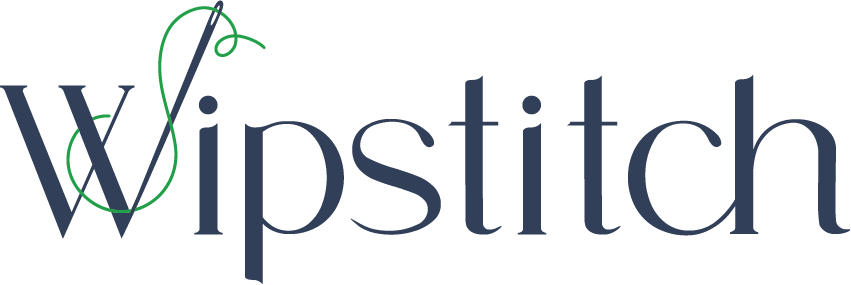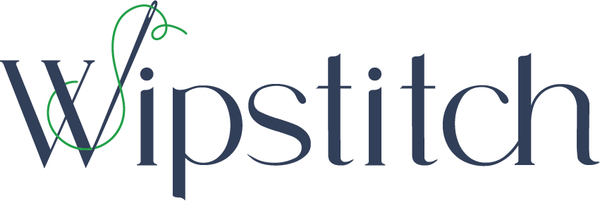Basic Terms for Needlepoint
Canvas – refers to the mesh fabric that needlepoint designs are painted on. Canvas typically comes in different sizes/mesh counts.
Mesh Count – The mesh count indicates the number of holes per square inch of the canvas. A higher count such as 18 mesh means there are 18 holes per square inch; so the holes are smaller compared to 13 mesh. 18 mesh is often used for smaller projects, provides greater detail in the design but can take longer to stitch. It also requires thinner threads. 13 mesh is great for larger projects such as pillows and trays and is a lot quicker to complete.
Binding – Refers to either the tape or fabric sewn around the edge of the canvas to prevent it from unraveling.
Stretcher Bars – Wooden bars that are combined to make a frame which you can tack your canvas to. Stretcher bars keep the canvas flat and even while you are stitching your project. Definitely recommended for decorative stitches.
Fibers or Thread – Thread is the essential element that brings your needlepoint canvas to life. There are all different kinds of threads from silk to wool and metallics. Each type of thread can add depth and richness to your project. Certain threads are suitable for certain mesh sizes.
Skein – This is the name for a unit of thread. In each skein is a certain number of yards.
Ply – Certain threads will have a ply number (3 ply, 6 ply) which refers to the number of strands that make up a single thread. Sometimes you will separate the ply to make a thinner thread.
Dye Lot – All threads are specifically dyed a certain color in batches. Sometimes the different batches can have slight variations. You always want to make sure you are using threads for a project from the same dye lot.
Tapestry Needle – Tapestry needles are the needle of choice for needlepoint. They are relatively short with a blunt point. Typically, needlepointers use two sizes of needles; size 22 for 18 mesh and size 20 for 13 mesh.
Needle Threader – A small tool that helps you thread your needle.
Kit – Everything you need to stitch a needlepoint canvas, which is typically a needle, canvas and fibers. Many online retailers offer kits on their sites.
Tension – Tension refers to the tightness and evenness of your stitches across your canvas. Consistent stitch tension makes your pieces look more attractive.
Decorative Stitches – Decorative stitches are those fancy stitches that you can use to add texture and dimension to your needlepoint projects.
WIP – Work In Progress – refers to your current needlepoint projects.
LNS – Local Needlepoint Shop – is typically a reference to a small, locally owned independent retail shop that specializing in selling needlepoint and needlepoint supplies.
NDLPT – Short for needlepoint
Frogging – The act of removing stitches that either were incorrect or you didn’t like.
Color Swap – You might find a canvas you love but you don’t love the colors. Color swapping is an easy way to personalize the project for your preferences. You can either just mentally switch the colors and stitch accordingly, or you can go the extra mile and paint over the colors you want to change on the canvas. Sometimes this can be better to make sure the original color does not peek through. If you do so, be sure to use an acrylic paint. There are lots of great acrylic paint pens on the market.
Stash – A playful way to refer to the dozens of canvases stitches have collected but not yet stitched.
Needleminder – A decorative magnet usually in a fun design that holds your needle to your canvas when you are not using it.
Finishing – When you are done stitching, you need to finish the flat canvas into whatever you want: an ornament, tray, pillow, frame, keychain, sunglass case etc.. You can either do this yourself or send it to a finisher to complete.
Mesh Count – The mesh count indicates the number of holes per square inch of the canvas. A higher count such as 18 mesh means there are 18 holes per square inch; so the holes are smaller compared to 13 mesh. 18 mesh is often used for smaller projects, provides greater detail in the design but can take longer to stitch. It also requires thinner threads. 13 mesh is great for larger projects such as pillows and trays and is a lot quicker to complete.
Binding – Refers to either the tape or fabric sewn around the edge of the canvas to prevent it from unraveling.
Stretcher Bars – Wooden bars that are combined to make a frame which you can tack your canvas to. Stretcher bars keep the canvas flat and even while you are stitching your project. Definitely recommended for decorative stitches.
Fibers or Thread – Thread is the essential element that brings your needlepoint canvas to life. There are all different kinds of threads from silk to wool and metallics. Each type of thread can add depth and richness to your project. Certain threads are suitable for certain mesh sizes.
Skein – This is the name for a unit of thread. In each skein is a certain number of yards.
Ply – Certain threads will have a ply number (3 ply, 6 ply) which refers to the number of strands that make up a single thread. Sometimes you will separate the ply to make a thinner thread.
Dye Lot – All threads are specifically dyed a certain color in batches. Sometimes the different batches can have slight variations. You always want to make sure you are using threads for a project from the same dye lot.
Tapestry Needle – Tapestry needles are the needle of choice for needlepoint. They are relatively short with a blunt point. Typically, needlepointers use two sizes of needles; size 22 for 18 mesh and size 20 for 13 mesh.
Needle Threader – A small tool that helps you thread your needle.
Kit – Everything you need to stitch a needlepoint canvas, which is typically a needle, canvas and fibers. Many online retailers offer kits on their sites.
Tension – Tension refers to the tightness and evenness of your stitches across your canvas. Consistent stitch tension makes your pieces look more attractive.
Decorative Stitches – Decorative stitches are those fancy stitches that you can use to add texture and dimension to your needlepoint projects.
WIP – Work In Progress – refers to your current needlepoint projects.
LNS – Local Needlepoint Shop – is typically a reference to a small, locally owned independent retail shop that specializing in selling needlepoint and needlepoint supplies.
NDLPT – Short for needlepoint
Frogging – The act of removing stitches that either were incorrect or you didn’t like.
Color Swap – You might find a canvas you love but you don’t love the colors. Color swapping is an easy way to personalize the project for your preferences. You can either just mentally switch the colors and stitch accordingly, or you can go the extra mile and paint over the colors you want to change on the canvas. Sometimes this can be better to make sure the original color does not peek through. If you do so, be sure to use an acrylic paint. There are lots of great acrylic paint pens on the market.
Stash – A playful way to refer to the dozens of canvases stitches have collected but not yet stitched.
Needleminder – A decorative magnet usually in a fun design that holds your needle to your canvas when you are not using it.
Finishing – When you are done stitching, you need to finish the flat canvas into whatever you want: an ornament, tray, pillow, frame, keychain, sunglass case etc.. You can either do this yourself or send it to a finisher to complete.



